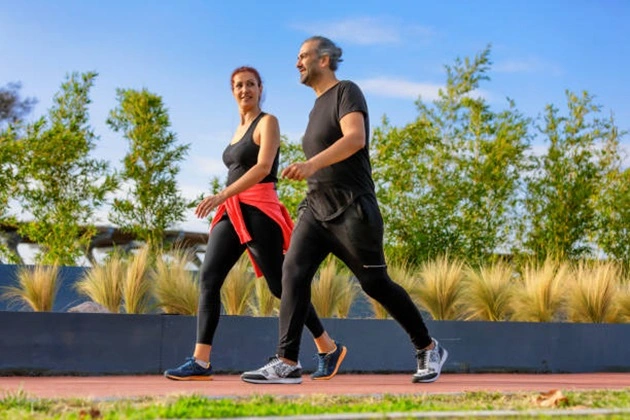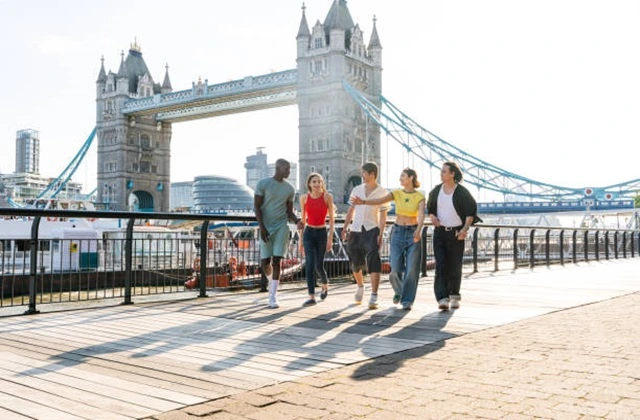Types of walking that improve health and workout variety

If you have just started your fitness journey or are looking for ways to diversify your usual workouts, pay attention to walking. Not for simple and familiar walks in the park at an easy pace, but steps turned into effective physical activity that can be performed anywhere. Take a closer look at these types of walking, which will help you once again take a walk in the fresh air and enjoy the benefits for your health.
7 types of walking that improve health and workout variety
1. Interval walking

As a rule, we walk at a comfortable pace: someone is faster, someone is slower. This allows us to cover long distances without fatigue. But often, the usual pace does not allow us to burn more calories, and it seems too casual. If you want to challenge the familiar and, at the same time, try a new load, choose interval walking. Set a timer on your phone or watch, for example, for five minutes.
At this time, walk faster than usual but still keep a moderate pace so as not to complete the workout too quickly. When the time runs out, set the timer for five minutes again and return to the usual pace. Alternate these intervals for an hour while working or walking in the park.
2. The step count
You might assume that walking outdoors is an automatic stress reliever, but that’s not always true. You’ve probably noticed that when you stroll through the streets of a city or a park, you still immerse yourself in your thoughts, which do not always turn out to be pleasant.
If you want to strengthen your physical and emotional health by walking, count your steps. This helps you “unload your head” and focus on the present moment rather than on thoughts about plans, difficulties, and other unpleasant things.
3. Walking with exercises

If there is a park with a sports ground near your house, look closer at this walking option. And if not, you can do the workout at home, pacing from room to room. You need to alternate between the steps and the usual exercises. For example, you can walk quickly for ten minutes and then do ten push-ups. Then, take time to walk again, stop, and lunge.
Other exercises that should be alternated with a walk include squats; bench presses with an expander and planks. Be sure to cycle through movements on different muscle groups to avoid overtraining.
4. Setting a personal record
We each have to visit the same places occasionally: shops, gym, work. And if you get to them on foot, you can make your walks part of the fitness program. Note the time it usually takes you to get to work — use a timer for this. Challenge yourself: every time you leave the house, try to cover the distance faster than the last time. But you don’t need to push yourself too hard: set a goal to arrive five to ten seconds earlier, increasing this time.
5. Social Walk

Meetings with friends do not necessarily have to occur in a cafe or at a table set at home. If your friends support a sporty lifestyle, invite them to join a “social walk.” Choose a comfortable route for all of you, put a bottle of water in your backpack, and go for a walk. Try to maintain a walking pace that is quick but comfortable for chatting.
What is the benefit of this practice? Firstly, physical activity shared with someone is perceived as easier and more pleasant. Secondly, this type of walking helps to get the pleasant emotions necessary to maintain mental health and make communication more qualitative and interesting. Finally, regular joint walks with friends can be a great way out if you lead a sedentary lifestyle and rarely devote time to sports.
6. Art-walking
A walk becomes more interesting if it has a purpose and looks more like a hobby than a physical activity. To diversify your leisure time, choose art walking as your new hobby. Check for enough memory on your phone, wipe the camera with a soft cloth, and hit the road. Set a goal for yourself — to take a beautiful picture to share it on a social network or send it to friends. Visit . A F R I N I K . C O M. For the full article . You can make an object of your attention a landscape that can be photographed by climbing a hill or birds in a park a few kilometers away.
As you cover the distance and walk comfortably, try to notice the beautiful things you can photograph. Focus the walk on beauty and details that usually escape your gaze. This kind of walking helps you practice and immerse yourself in the present moment, and it can also bring pleasant emotions from the time spent alone. It’s also a great way to practice creative thinking.
7. A walk before going to bed

This type of walk is suitable for those who face sleep problems and as an alternative to a late-evening snack. Go outside at a late hour and start moving at a slow, measured pace. Try to make sure that your walking session ends about an hour and a half before you go to bed. A slow step combined with deep breathing is a great way to relax and find peace of mind. Such a calm workout will help relieve stress and help you fall asleep faster.




